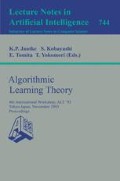Abstract
Automated knowledge acquisition is an important research issue in machine learning. There have been proposed several methods of inductive learning, such as ID3 family and AQ family. These methods are applied to discover meaningful knowledge from large database, and their usefulness is in some aspects ensured. However, in most of the cases, their methods are of deterministic nature, and the reliability of acquired knowledge is not evaluated statistically, which makes these methods ineffective when applied to the domain of essentially probabilistic nature, such as medical one. Extending concepts of rough set theory to probabilistic domain, we introduce a new approach to knowledge acquistion, which induces probabilistic rules based on rough set theory(PRIMEROSE) and develop an program that extracts rules for an expert system from clinical database, based on this method. The results show that the derived rules almost correspond to those of the medical experts.
Preview
Unable to display preview. Download preview PDF.
References
Breiman, L., Freidman, J., Olshen, R., and Stone, C. Classification And Regression Trees. Belmont, CA: Wadsworth International Group, 1984.
Efron B. The Jackknife,the Bootstrap and Other Resampling Plans. Pensylvania:CBMS-NSF, 1982.
Kimura, M, et al. RHINOS: A Consultation System for Diagnoses of Headache and Facial Pain: RHINOS, Proc. of IJCAI-85,393–396, Morgan Kaufmann, 1985.
Hyafil, L and Rivest, R.L. Constructing Optimal Binary Decision Trees is NP-complete. Information Processing Letters, 1976.
Chandrasekaran, B. and Jain, A.K. Quantization complexity and independent measurements IEEE Trans. Comput., 23, 102–106, 1974.
Matsumura, Y, et al. Consultation system for diagnoses of headache and facial pain: RHINOS, Medical Informatics, 11, 145–157, 1986.
Matsumura, Y, et al. Consultation system for diagnoses of headache and facial pain: RHINOS2, Proc. of Logic Programming Conference '85, Spring Verlag, 1985.
McLachlan, G.J. Discriminant Analysis and Statistical Pattern Recognition, John Wiley and Sons,1992.
Michalski, R.S. A Theory and Methodology of Machine Learning. Michalski, R.S., Carbonell, J.G. and Mitchell, T.M., Machine Learning — An Artificial Intelligence Approach, Morgan Kaufmann,1983.
Michalski, R.S., et al. The Multi-Purpose Incremental Learning System AQ15 and its Testing Application to Three Medical Domains, Proc. of AAAI-86, 1041–1045, Morgan Kaufmann, 1986.
Mingers, J. An Empirical Comparison of Selection Measures for Decision Tree Induction. Machine Learning, 3, 319–342, 1989.
Mingers, J. An Empirical Comparison of Pruning Methods for Decision Tree Induction. Machine Learning, 4, 227–243, 1989.
Pawlak, Z Rough Sets, Kluwer Academic Publishers, 1991.
Quinlan, J.R. Induction of decision trees, Machine Learning, 1, 81–106, 1986.
Shapiro, G.P. and Frawley, W.J.(eds) Knowledge Discovery in Datatbases, AAAI press, 1991.
Slowinski, K et al. Rough sets approach to analysis of data from peritoneal lavage in acute pancreatitis, Medical Informatict, 13, 143–159, 1988.
Tsumoto, S. and Tanaka, H. Comparing inductive learning methods in the framework of the combination of rough set theory and matroid theory. to be appeared, 1993.
Welsh, D.J.A. Matroid Theory, Academic Press,1976.
Whitney, H. On the abstract properties of linear dependence, Am. J. Math., 57,509–533,1935.
Ziarko, W The Discovery,Analysis, and Representation of Data Dependencies in Databases, in:Knowledge Discovery in Database, Morgan Kaufmann, 1991.
Author information
Authors and Affiliations
Editor information
Rights and permissions
Copyright information
© 1993 Springer-Verlag Berlin Heidelberg
About this paper
Cite this paper
Tsumoto, S., Tanska, H. (1993). Induction of probabilistic rules based on rough set theory. In: Jantke, K.P., Kobayashi, S., Tomita, E., Yokomori, T. (eds) Algorithmic Learning Theory. ALT 1993. Lecture Notes in Computer Science, vol 744. Springer, Berlin, Heidelberg. https://doi.org/10.1007/3-540-57370-4_64
Download citation
DOI: https://doi.org/10.1007/3-540-57370-4_64
Published:
Publisher Name: Springer, Berlin, Heidelberg
Print ISBN: 978-3-540-57370-8
Online ISBN: 978-3-540-48096-9
eBook Packages: Springer Book Archive

